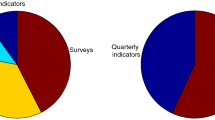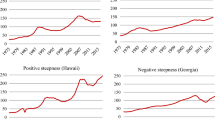Abstract
In the last decades, the interest in the relationship between crime and business cycle has widely increased. It is a diffused opinion that a causal relationship goes from economic variables to criminal activities, but this causal effect is observed only for some typology of crimes, such as property crimes. In this work we examine the possibility of the existence of some common factors (interpreted as cyclical components) driving the dynamics of Gross Domestic Product and a large set of criminal types by using the nonparametric version of the dynamic factor model. A first aim of this exercise is to detect some comovements between the business cycle and the cyclical component of some typologies of crime, which could evidence some relationships between these variables; a second purpose is to select which crime types are related to the business cycle and if they are leading, coincident or lagging. Italy is the case study for the time span 1991:1–2004:12; the crime typologies are constituted by the 22 official categories classified by the Italian National Statistical Institute. The study finds that most of the crime types show a counter-cyclical behavior with respect to the overall economic performance, and only a few of them have an evident relationship with the business cycle. Furthermore, some crime offenses, such as bankruptcy, embezzlement and fraudulent insolvency, seem to anticipate the business cycle, in line with recent global events.




Similar content being viewed by others
Notes
It is important to note that in Italy, unlike the United States, such crime does not include intentional damages, like vandalism.
This form of illegal activity is generally associated with false accounting by managers in order to divert resources for personal use and gain.
SAF offences are connected with the sales of adulterated foodstuffs. They include any undesirable adulteration in foodstuffs or reduction or extraction of any natural quality or utility from foodstuffs in order to maintain health and convenience of the general public.
We use (2m + 1) values for ω, with \(\omega_k=1-\frac{|k|}{m+1}\), with \(k=-m, \ldots,m\) and \(m=\hbox{round}(\frac{\sqrt{T}}{4})\), as suggested in Forni et al. (2000).
To save space we do not show these results, that are available on request.
Correlations from lag (lead) 6 to 12 are less than 0.01, so, to save space, we do not report them.
We are in debt to an anonymous referee for this interpretation.
Such choice of a threshold value for the common component correlations and for the variance ratio is quite subjective. The values used here are proposed by Fiorentini and Planas (2003).
The analysis has been performed using different threshold values of the explained variance; remarkably, the results do not change up to a threshold value of 65%, showing a good level of robustness.
References
Altissimo F, Marchetti DJ, Oneto GP (2000) The Italian business cycle: coincident and leading indicators and some stylized facts. Temi di Discussione del Servizio Studi-Banca d’Italia 377
Altissimo F, Bassanetti A, Cristadoro R, Forni M, Lippi M, Hallin M, Reichlin L, Veronese G (2001) Eurocoin: a real time coincident indicator of the Euro area business cycle. CEPR Discussion Paper 3108
Arvanites TM, Defina RH (2006) Business cycles and street crime. Criminology 44:139–164
Bauwens L, Laurent S, Rombouts JVK (2006) Multivariate GARCH models: a survey. J Appl Econom 21:79–109
Becker G (1968) Crime and punishment: an economic approach. J Polit Econ 76:169–217
Box S (1987) Recession, crime and punishment. Palgrave Macmillan, London
Brillinger DR (1981) Time series data analysis and theory. Holden-Day, San Francisco
Bruno G, Otranto E (2008) Models to date the business cycle: the Italian case. Econ Model 25:899–911
Buonanno P (2003) The socioeconomic determinants of crime: a review of the literature. Working papers 63, University of Milano-Bicocca, Department of Economics
Cantor D, Land K (1985) Unemployment and crime rates in the post World War II United States: a theoretical and empirical analysis. Am Sociol Rev 50:317–332
CEPR (2009) Euro area business cycle dating committee: determination of the 2009 Q2 trough in economic activity. CEPR Document
Cohen LE, Felson M (1979) Social change and crime rate trends: a routine activity approach. Am Sociol Rev 44:588–608
Cook PJ, Zarkin GA (1985) Crime and the business cycle. J Legal Stud 14:115–128
Corman H, Joyce T, Lovitch N (1987) Crime, deterrence, and the business cycle in New York: a VAR approach. Rev Econ Stat 69:695–700
Delli Gatti D, Gallegati M, Greenwald BC, Russo A, Stiglitz JE (2009) Business fluctuations and bankruptcy avalanches in an evolving network economy. J Econ Interact Coord 4:195–212
Detotto C, Otranto E (2010) Does crime affect economic growth? Kyklos 63:330–345
Detotto C, Vannini M (2010) Counting the cost of crime in Italy. Glob Crime 11:421–435
Favero CA, Marcellino M, Neglia F (2005) Principal components at work: the empirical analysis of monetary policy with large data sets. J Appl Econ 20:603–620
Fernandez RB (1981) A methodological note on the estimation of time series. Rev Econ Stat 63:471–478
Field S (1990) Trends in crime and their interpretation: a study of recorded crime in post-war England and Wales. Home Office Research Study 119. Home Office, London
Field S (1999) Trends in crime revisited. Home Office Research Study 195. Home Office, London
Fiorentini G, Planas C (2003) Busy program user manual. Joint Research Centre of European Commission Document
Forni M, Hallin M, Lippi M, Reichlin L (2000) The generalised dynamic factor model: identification and estimation. Rev Econ Stat 82:540–554
Forni M, Hallin M, Lippi M, Reichlin L (2001) Coincident and leading indicators for the Euro area. Econ J 111:62–85
Fougre D, Kramarz F, Pouget J (2007) Youth unemployment and crime in france. CREST-INSEE working paper, 33
Gomez V, Maravall A (1997) Program TRAMO (Time Series Regression with ARIMANoise, Missing Observations, and Outliers) and SEATS(SignalExtraction in ARIMA Time Series) Instructions for the User. Madrid, Secretaria de Estado de Hacienda
Gould D, Mustard D, Weinberg B (2002) Crime rates and local labour market opportunities in the United States: 1979–1997. Rev Econ Stat 84:45–61
Greenberg DF (2001) Time series analysis of crime rates. J Q Criminol 17:291–327
Hale C (1998) Crime and the business cycle in post war Britain revisited. Br J Criminol 38:681–698
Hale C (1999) The labour market and post-war crime trends in England and Wales. In: Carlen P, Morgan R (eds) Crime unlimited: questions for the 21st century. Macmillan, London, pp 30–56
Istat (2004) La Sicurezza dei Cittadini. Reati, Vittime, Percezione della Sicurezza e Sistemi di Protezione. Istat, Rome
Mansour JM (2003) Do national business cycles have an international origin? Empir Econ 28:223–247
Mariano RS, Murasawa Y (2003) A new coincident index of business cycles based on monthly and quarterly series. J Appl Econ 18:427–443
Mauro P (1995) Corruption and growth. Q J Econ 110:681–712
Otranto E (2005) Extracting a common cycle from series with different frequency: an application to the Italian economy. J Bus Cycle Meas Anal 2:407–430
Paternoster R, Bushway SD (2001) Theoretical and empirical work on the relationship between unemployment and crime. J Q Criminol 17:391–407
Phillips PCB, Perron P (1988) Testing for a unit root in time series regression. Biometrika 75:335–346
Pyle DJ, Deadman DF (1994) Crime and business cycle in post-war Britain. Br J Criminol 34:339–357
Rosenfeld R (2009) Crime is the problem: homicide, acquisitive crime, and economic conditions. J Q Criminol 25:287–306
Sargent TJ, Sims CA (1977) Business cycle modelling without pretending to have too much a priori economic theory. In: Sims CA (eds) New methods in business research. Federal Reserve Bank of Minneapolis, Minneapolis
Stock JH, Watson MW (1993) A probability model of the coincident economic indicators. In: Lahiri K, Moore GH (eds) Leading economic indicators: new approaches and forecasting records. Cambridge University Press, New York, pp 63–89
Stock JH, Watson MW (2002) Diffusion indexes. J Bus Econ Stat 20:147–162
Taylor I (2002) Liberal markets and the Republic of Europe: contextualizing the growth of transnational organized crime. In: Berdal MR, Serrano M (eds) Transnational organized crime and international security: business as usual? Lynne Rienner Publisher, London, pp 119--153
Acknowledgements
We would like to thank the three anonymous referees for their detailed reading of the paper and many comments which led to a clearer focus of the paper. We also thank Christophe Planas, Alessio Scano and Marco Vannini for their useful suggestions. Financial support from Italian MIUR under Grants 20087Z4BMK_002 and 2006137221_001 are gratefully acknowledged
Author information
Authors and Affiliations
Corresponding author
Rights and permissions
About this article
Cite this article
Detotto, C., Otranto, E. Cycles in Crime and Economy: Leading, Lagging and Coincident Behaviors. J Quant Criminol 28, 295–317 (2012). https://doi.org/10.1007/s10940-011-9139-5
Published:
Issue Date:
DOI: https://doi.org/10.1007/s10940-011-9139-5




